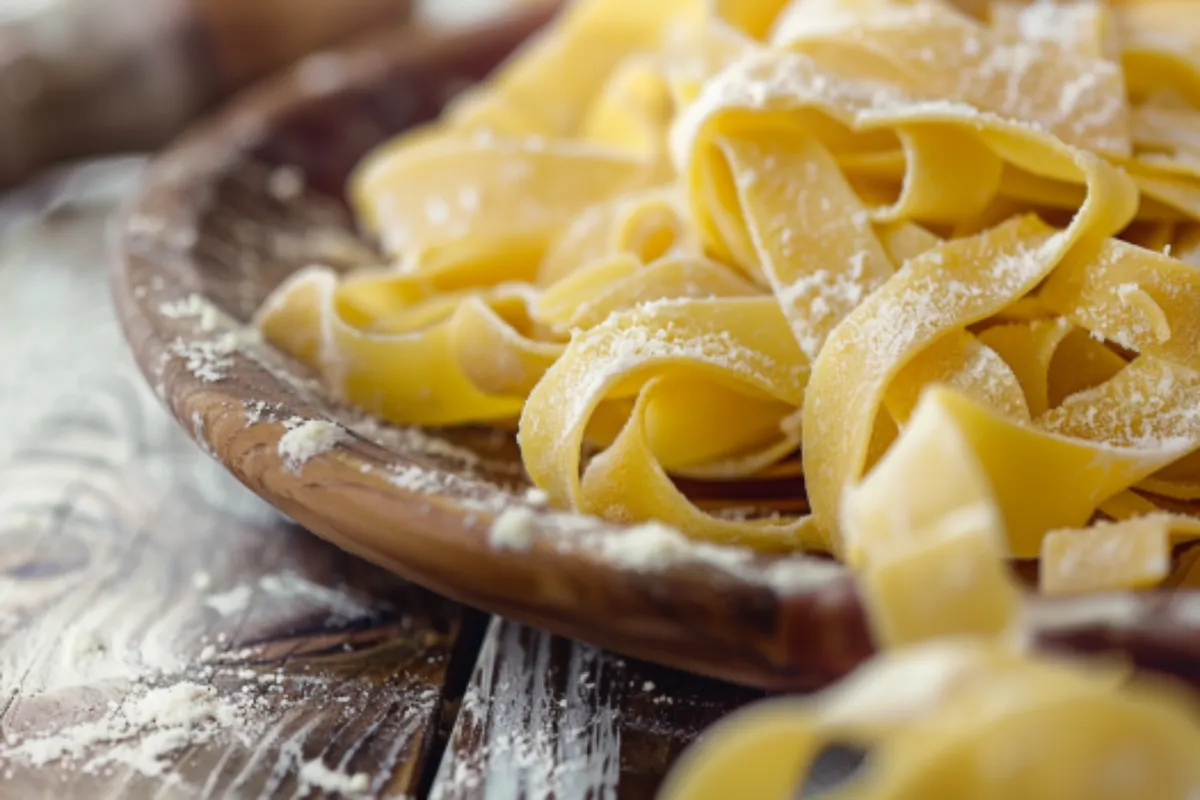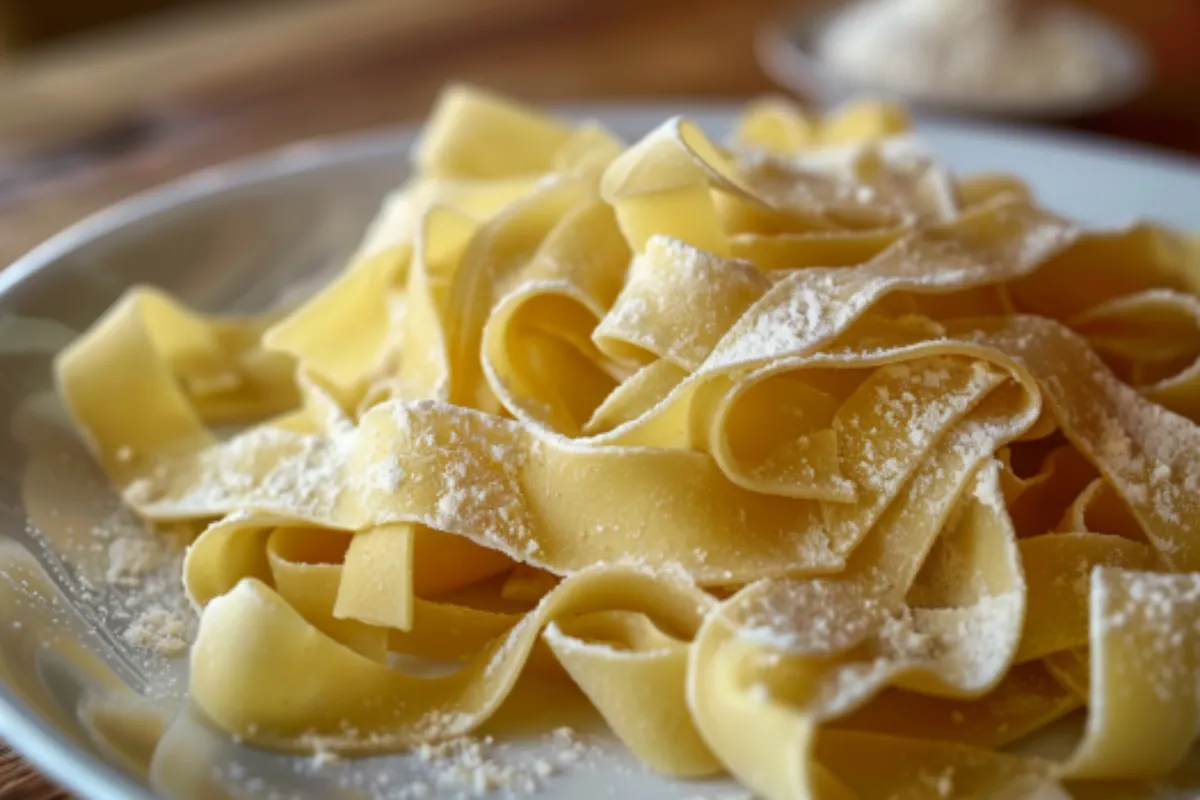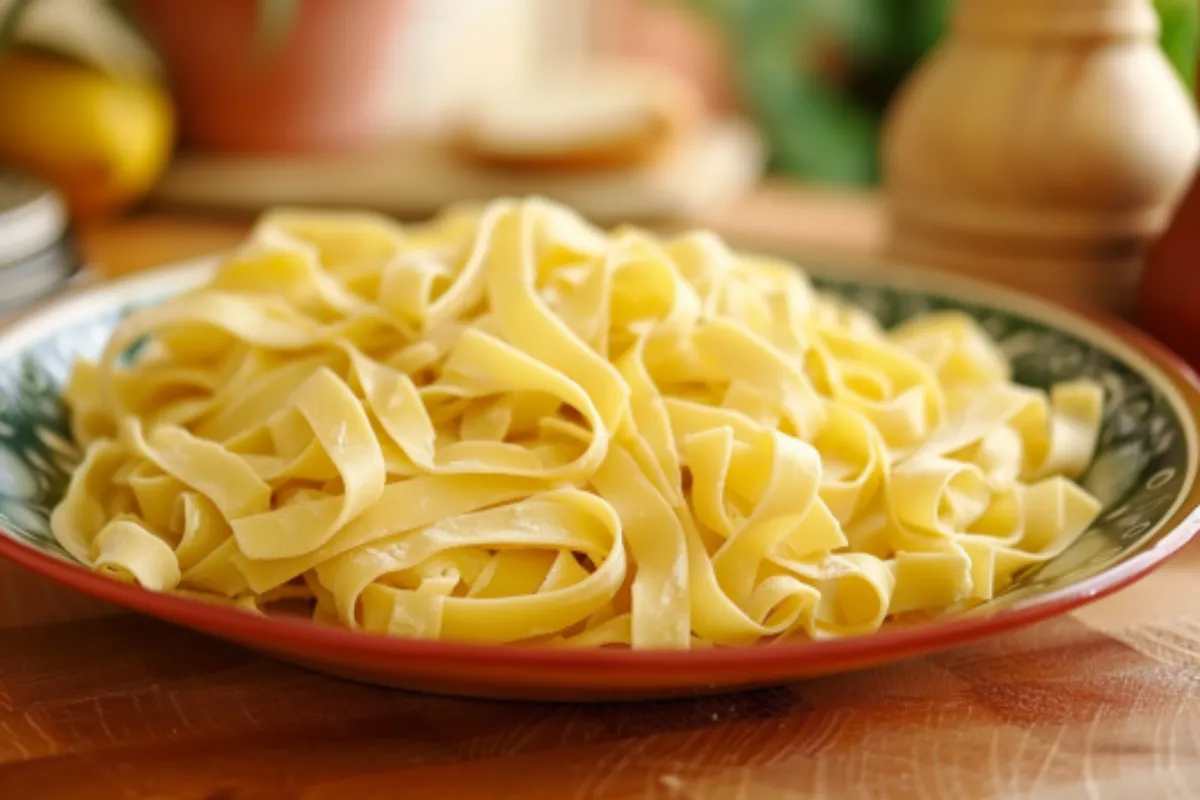Pappardelle pasta, with its broad, flat ribbons, is a versatile and beloved staple in Italian cuisine. Originating from the Tuscany region, it has gained global popularity due to its ability to pair with a wide range of sauces and ingredients. But what exactly do you use pappardelle pasta for, and how can you make the most out of this delightful pasta in your kitchen?
Whether you’re an experienced chef or a home cook looking to experiment, understanding the best uses of pappardelle can elevate your culinary creations. From traditional recipes to modern twists, this guide will provide a comprehensive overview of how to use pappardelle to its fullest potential. For more pasta ideas, you might find inspiration in dishes like Birria Tacos, which also celebrate robust flavors.
What is Pappardelle Pasta?

Pappardelle is a type of Italian pasta characterized by its wide, flat shape, typically about 2-3 cm in width. The pasta often uses an egg-based dough, giving it a rich and silky texture that pairs beautifully with hearty sauces. The name “pappardelle” comes from the Italian word “pappare,” which means “to gobble up,” reflecting its appeal in satisfying, robust dishes.
Cooks in Tuscany, where pappardelle pasta is particularly popular, often serve it with meat-based sauces like wild boar ragu. Its broad surface makes it ideal for capturing thicker sauces, ensuring each bite is flavorful and satisfying. Learn more about pairing different pasta shapes with sauces in our Ultimate Guide to Pasta Recipes.
History and Origins of Pappardelle
Pappardelle traces its roots back to Tuscany, where cooks traditionally made it by hand. It likely originated during the Renaissance, a time when pasta-making flourished as an art form. Tuscan cooks preferred this wide ribbon pasta for its ability to complement their rich, game-based sauces, particularly those made with wild boar and hare. Learn more about the history of pasta and its evolution in Italian cuisine.
During this era, pasta was becoming a symbol of wealth and culinary refinement in Italy. As more households adopted the practice of making pasta, the popularity of different shapes grew, with pappardelle becoming particularly beloved for its versatility and ease of preparation. The pasta’s large, flat surface area made it perfect for holding onto thick, chunky sauces, which were a staple of Tuscan cuisine.
Over time, pappardelle spread beyond Tuscany, gaining favor across Italy and eventually around the world. Today, it remains a favorite in both home kitchens and upscale restaurants, valued for its ability to transform a simple dish into a hearty, satisfying meal.
How Pappardelle Differs from Other Pasta Types
While pappardelle might seem similar to other wide pasta types like fettuccine or tagliatelle, it has distinct qualities. You can explore more in this guide to pasta shapes.
- Width and Texture: Pappardelle is usually broader than tagliatelle and fettuccine, with a width that allows it to capture more sauce and flavor. This width also gives it a more substantial bite, which is perfect for those who enjoy a heartier pasta experience.
- Ideal Pairings: The wide, flat ribbons make pappardelle perfect for thicker, meat-based sauces that cling well to its surface. It excels in dishes where the sauce is the star, as the pasta provides the perfect vehicle for delivering those flavors.
- Cooking Versatility: Pappardelle can be used in a wide variety of recipes, from traditional Italian dishes to modern fusion cuisine. Its versatility means it can be paired with nearly any type of sauce or ingredient, making it a staple in many kitchens.
Traditional Uses of Pappardelle Pasta
Pappardelle is traditionally used in:
- Classic Italian Dishes: One of the most traditional uses of pappardelle is in pappardelle al cinghiale, a dish featuring wild boar ragu. The broad noodles hold up well against the rich, gamey sauce, allowing each bite to be packed with flavor. Other classic pairings include rabbit ragu, duck ragu, and hearty beef or lamb stews.
- Hearty Stews and Ragùs: Pappardelle is a popular choice for ragùs, the Italian term for meat-based sauces that have been slow-cooked to perfection. These sauces often feature beef, pork, or lamb, along with tomatoes, wine, and a variety of herbs and spices. The broad, flat surface of pappardelle allows it to soak up the sauce and deliver a rich, flavorful experience.
- Creamy Sauces: While pappardelle is often paired with meat-based sauces, it also works wonderfully with creamy sauces like Alfredo. The wide noodles provide an excellent base for rich, velvety sauces, ensuring that each bite is satisfying and delicious.
Modern and Creative Uses of Pappardelle Pasta

Beyond traditional dishes, pappardelle pasta is also used in various creative and modern recipes:
- Vegetarian Options: Pappardelle can be used to create hearty vegetarian dishes that are just as satisfying as their meat-based counterparts. Pair it with a mushroom ragu, made with a variety of mushrooms, onions, garlic, and herbs, for a dish that is rich in umami flavors. Alternatively, use it in a simple preparation with fresh tomatoes, basil, and a generous drizzle of olive oil for a light, refreshing dish.
- Fusion Dishes: Pappardelle is versatile enough to be used in fusion dishes that combine elements from different cuisines. For example, you can create an Asian-inspired dish by pairing pappardelle with ingredients like tofu, miso, or sesame. The pasta’s wide shape allows it to hold onto sauces with ease, making it a great choice for fusion cooking.
- Seafood Dishes: Pappardelle also works well in seafood dishes. Try it with a sauce made from fresh prawns, scallops, or lobster, along with a light tomato or white wine sauce. The broad noodles help capture the delicate flavors of the seafood, making for a delicious and elegant meal.
Pappardelle Pasta in Soups and Salads
- Soups: Pappardelle can add texture and substance to soups, especially those that are hearty and filling. Consider incorporating it into minestrone, a classic Italian vegetable soup, where the wide noodles add a satisfying bite. Alternatively, use it in a chicken noodle soup for a twist on the traditional recipe.
- Pasta Salads: Pappardelle can also be used in cold pasta salads, where its wide ribbons provide an interesting texture and shape. Combine it with fresh vegetables, olive oil, lemon juice, and herbs for a light, refreshing dish that is perfect for summer picnics or potlucks.
Pappardelle for Special Occasions and Entertaining
Pappardelle’s versatility makes it a popular choice for special occasions:
- Holiday Meals: Many people include pappardelle in festive menus, paired with rich sauces like truffle cream or lobster. Its wide ribbons provide a beautiful base for these luxurious ingredients, making it an ideal choice for a holiday or celebration meal.
- Elegant Presentations: When serving pappardelle for a special occasion, consider arranging the pasta neatly on plates, garnished with fresh herbs and a sprinkling of parmesan cheese. This simple presentation can elevate the dish and make it look more refined and sophisticated.
How to Cook Pappardelle Pasta Perfectly
Cooking pappardelle pasta correctly is key to achieving the perfect texture:
- Boil in Salted Water: Start by bringing a large pot of salted water to a boil. Add the pappardelle and cook for about 7-9 minutes, or until al dente. The pasta should be tender but still have a slight bite.
- Stir Occasionally: Stir the pasta occasionally while it cooks to prevent it from sticking together.
- Reserve Some Pasta Water: Before draining the pasta, reserve a cup of the cooking water. This starchy water helps emulsify the sauce, ensuring it clings to the pasta evenly.
- Finish in the Sauce: For the best results, finish cooking the pasta in the sauce. This allows the pasta to absorb the flavors of the sauce and ensures a cohesive dish.
For more insights into perfect pasta dishes, consider trying recipes from our Ultimate Pasta Recipe Collection.
Best Sauces and Ingredients to Pair with Pappardelle
- Thick, Hearty Sauces: Pappardelle pairs beautifully with thick, hearty sauces like meat ragùs, Bolognese, and other slow-cooked sauces. The wide noodles provide the perfect vehicle for these rich, flavorful sauces, ensuring each bite is satisfying.
- Vegetables and Herbs: Fresh vegetables and herbs are also great pairings for pappardelle. Try it with a sauce made from sautéed mushrooms, zucchini, or spinach, along with fresh basil, rosemary, or parsley for added flavor.
- Cheese: Finish your pappardelle dishes with a generous sprinkling of parmesan, pecorino, or gorgonzola cheese. These cheeses add a rich, salty flavor that complements the pasta perfectly.
Gluten-Free and Whole Wheat Pappardelle Options
For those with dietary restrictions, consider several alternatives to traditional pappardelle:
- Gluten-Free Options: Gluten-free pappardelle often uses rice flour, corn flour, or a blend of gluten-free grains. It provides a texture similar to traditional pappardelle and works in all the same recipes.
- Whole Wheat Pappardelle: Whole wheat pappardelle, made from whole wheat flour, offers a nuttier flavor and a slightly firmer texture. It is a great option for those looking to add more fiber to their diet.
- Cooking Tips for Alternatives: Both gluten-free and whole wheat pappardelle may require slightly different cooking times, so follow the instructions on the package for the best results.
Tips for Buying and Storing Pappardelle Pasta
- Where to Buy: Look for pappardelle in Italian specialty stores, online, or well-stocked supermarkets. Fresh pappardelle is often found in the refrigerated section, while dried versions are available in the pasta aisle.
- Selecting Quality: When buying dried pappardelle, choose pasta with a rough texture. This rough surface helps sauces adhere better, making for a more flavorful dish.
- Storage Recommendations: Store dried pappardelle in a cool, dry place, away from direct sunlight. Refrigerate fresh pappardelle and use it within a few days. You can also freeze fresh pasta for longer storage.
Creative Pappardelle Recipes to Try

Here are some exciting recipes to try using pappardelle:
- Pappardelle with Mushroom and Truffle Oil: Sauté a mix of wild mushrooms with garlic and olive oil. Toss the cooked pappardelle with the mushrooms and finish with a drizzle of truffle oil and grated parmesan.
- Lemon Pappardelle with Asparagus: Cook pappardelle and toss it with sautéed asparagus, lemon zest, and a light cream sauce. Top with fresh basil and pine nuts for added flavor.
- Spicy Sausage Pappardelle: Brown some Italian sausage with red pepper flakes, garlic, and onions. Toss with pappardelle and a tomato-based sauce for a spicy, savory dish.
- Pappardelle with Duck Ragu: Slow-cook duck legs with tomatoes, red wine, and aromatics to create a rich ragu. Serve over pappardelle for a luxurious meal.
Frequently Asked Questions About Pappardelle Pasta
1. What is pappardelle pasta best used for?
Pappardelle is best used with thick, hearty sauces like meat ragùs, Bolognese, or rich cream-based sauces that cling to its wide, flat ribbons.
2. How do I cook pappardelle pasta?
Cook pappardelle in salted boiling water for 7-9 minutes, or until al dente. Stir occasionally and reserve some pasta water to help emulsify the sauce.
3. Can I make pappardelle pasta at home?
Yes, you can easily make pappardelle at home using simple ingredients like flour, eggs, and a pinch of salt. Check out our guide on how to make fresh pappardelle.
4. What dishes can I make with pappardelle?
You can make a variety of dishes with pappardelle, such as pappardelle al cinghiale (wild boar ragu), mushroom and truffle oil pappardelle, seafood pappardelle with prawns, or even a lemon and asparagus pappardelle.
5. Is there a gluten-free version of pappardelle?
Yes, gluten-free versions of pappardelle are available, typically made with rice flour, corn flour, or a blend of gluten-free grains.
6. Can pappardelle pasta be used in soups or salads?
Absolutely! Pappardelle works well in hearty soups like minestrone or chicken noodle soup and can add a delightful texture to cold pasta salads.
Conclusion
Pappardelle pasta’s wide ribbons and robust texture make it a versatile choice for a variety of dishes. From traditional Italian classics to modern culinary creations, you can pair this pasta type with numerous sauces and ingredients, offering endless possibilities in the kitchen. So, whether you’re making a hearty stew, a delicate seafood dish, or an innovative fusion recipe, pappardelle is an excellent option to have on hand.
Use these tips and recipes to explore the many uses of pappardelle pasta and enjoy its delightful taste and texture in your favorite dishes!

